This post contains affiliate links. We may get paid an affiliate commission if you buy something or take an action after clicking one of the links on this web page.
Last Updated: August 5, 2019
I have spoken about the revival of interest in traditional slip joint knives a few times now. Today we have another slip joint review, but rather than featuring a traditional knife today’s blade could not be a more progressive collaboration. Acclaimed Scandinavian custom knife makers Jens Anso and Jesper Voxnaes have joined forces with Spyderco to bring us the Pingo, a completely modern slip joint folder.
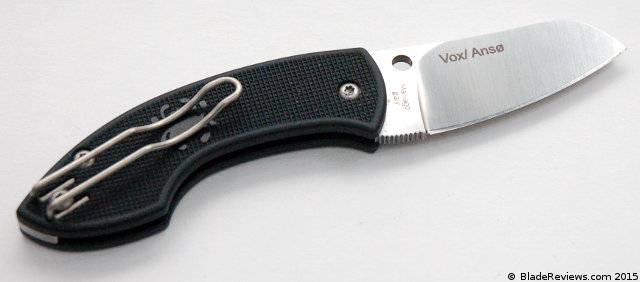
Buy the Spyderco Pingo at BladeHQ
The idea with the Pingo was to make a folding knife that is legal to carry in Denmark, which doesn’t allow for locking folders or folders you can open with one hand. Both Jesper and Jens are from Denmark. Although that hasn’t stopped them from making all manner of bad ass folding knives, they apparently wanted to provide something even their countrymen could enjoy.
General Dimensions and Blade Details
The Pingo has an overall length of 5.80″, a 2.35″ blade, and weighs 1.9 ounces. This is a lightweight and slim every day carry (EDC) knife that disappears into the pocket. I can’t help but compare this to the Dragonfly 2, a knife I refer to as the Pingo’s distant cousin. It is also small, features a linerless FRN handle, and has a wire pocket clip. The Pingo is a great size for daily carry and should be legal to use pretty much anywhere knives are allowed.
The sheepsfoot blade of the Pingo is funky and functional. The high flat grind makes it a capable slicer, while the absence of a serious tip make the Pingo great for delicate tasks. Case in point, I used the Pingo to cut away a bandage from my dog’s foot the other week. It worked great – both animal and handler walked away without any problems. Denmark’s law for folders restricts blade lengths to 2.756″. The Pingo easily meets the standard with its 2.35″ blade. While 2.35″ isn’t a ton of blade to work with, I got a lot done with the knife. It easily broke down boxes, opened mail, and performed mild food prep. The knife is also fine for harder chores like cutting rope and whittling wood. The absence of a serious tip doesn’t make this ideal for stabbing things or cutting out coupons, but for most tasks the Pingo was fine.
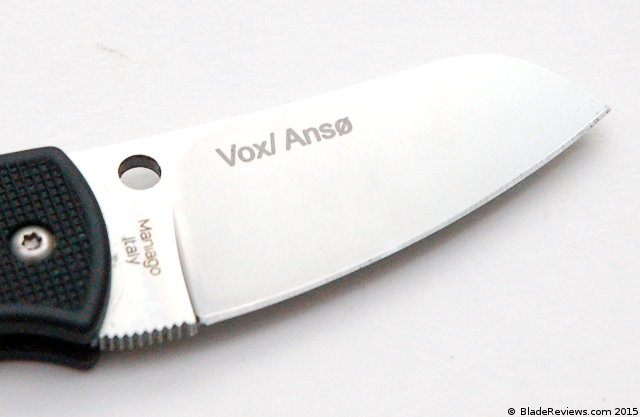
The Pingo is made in Maniago Italy and features a blade of Böhler-Uddeholm’s N690 stainless steel. N690 is great stuff and I would compare it to something like 154CM or CTS-XHP in that it holds a nice edge but it is still easy to sharpen. It gets screaming sharp with very little effort. It is also very resistant to rust and corrosion. I have really come to enjoy N690 and was pleased to see it on the Pingo.
Handle, Ergonomics, and Pocket Clip
The Pingo has a simple FRN handle with a stainless steel backspacer / spring. The FRN has a very fine waffle iron texture to it. It provides good grip but I find that it holds dirt and the little pores get clogged. Not a problem really until you decide to photograph the knife for the world to see. I’m not a huge fan of the oversize Spyderco bug logo in the center of the handle. I have never been a fan of over the top branding, and would have preferred something a little more restrained.
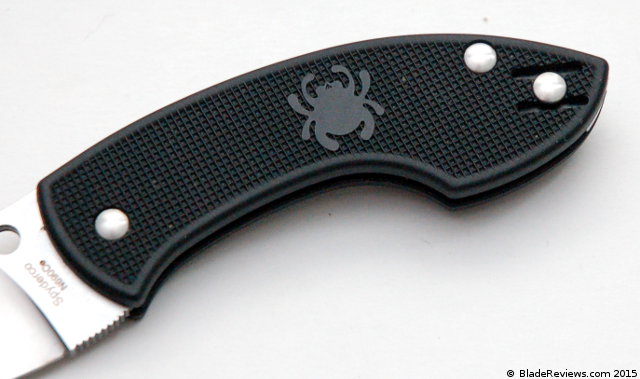
With all of that said, the overall handle construction is great. The button head hardware is nice and simple, and each edge of the handle has been rounded for comfort. The absence of any kind of liners make the knife extremely lightweight. While I wouldn’t pry with this knife, I am not concerned about the strength of the handle under normal use.
The overall shape of the handle is kind of elf-like, and the whole knife has a sort of otherworldly vibe to it. I will say that it feels great in hand. The simple elongated handle has plenty of room for all 4 fingers. A small run of jimping on the choil area of the blade holds your index finger in place. The absence of jimping on the spine makes the knife comfortable to use. This is a great little knife for lighter tasks.
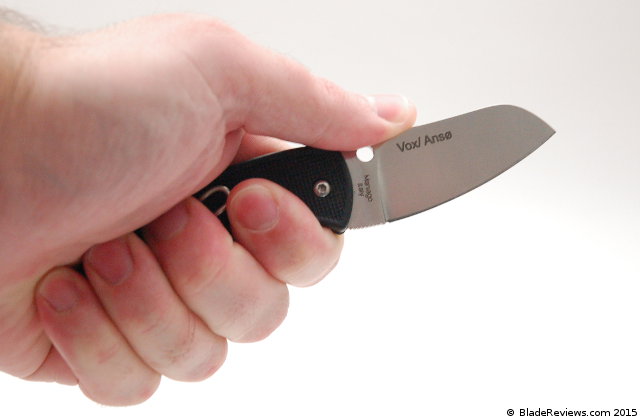
Spyderco included the wire clip on the Pingo, which happens to also be on the Sage 1 and Dragonfly 2, a couple of my favorite Spydies. So I might be a bit biased when I say that I really like the clip on the Pingo. It’s simple, discrete, and highly functional.
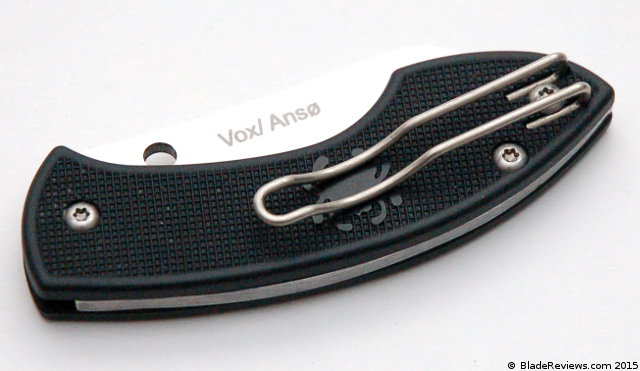
In pocket the Pingo carries beautifully. It’s a wider knife, but slim and lightweight. Perfect for urban daily carry.
Deployment and Lockup
The whole point of the Spyderco Pingo is that you are not supposed to be able to open the knife with one hand. The knife is hard to open one handed, but with some finger gymnastics I can still get it done. The back spring or (“pull”) isn’t super strong, but feels appropriate and I’m not afraid of the blade falling out of the handle or anything like that. The pivot is smooth, and the action is crisp as the blade slides into its half stop, and then opens completely with a satisfying snap. All said this is a well implemented slip joint. Spyderco did include their trademarked round hole here, and when the knife is closed the hole sort of winks out at you over the FRN scales.
Here is the Pingo next to my Dragonfly 2:
Of course being a slip joint there is no lock on the knife. Personally this doesn’t turn me off and I think it is fine for an EDC knife (at least for my purposes). People have been using slip joints as work knives for hundreds of years. You just need to be careful with it and treat the tool with respect.
There is no blade play to speak of, and blade centering is perfect.
Spyderco Pingo Review – Final Thoughts
The Pingo strikes me as an excellent convergence of traditional sensibility, forward design, and modern materials. It appears simple enough, but this is a deceptively refined knife from the benches of two of the hottest custom makers on the market. The choice of materials is great and the fit and finish is good (not amazing, there are some tooling marks on the inside of the spring and the spring bows out ever so slightly from the handle at one point). Although it’s not a locking folder, it’s still a practical choice for EDC, even if you can carry a locking folder in your jurisdiction.
The Pingo is also priced attractively at under $50. I have been critical of Spyderco for mostly introducing expensive knives these days, so I have to give credit where it’s due. The Pingo is accessible, and it doesn’t feel cheap either.
If you are torn between this and the Dragonfly 2 (and your local laws allow you to carry both) I would probably recommend the Dragonfly because you can open it with one hand and it locks. But the Pingo is still a fun and functional knife and worth your consideration. Ultimately, you can’t go wrong either way. Recommended.
- Made using the highest quality materials
- Tested for quality and durability
- The most trusted name in you cutlery needs
- Two-hand opening Slip It
- Reversible wire clip
I recommend purchasing the Pingo at Amazon or BladeHQ. Thanks for reading.
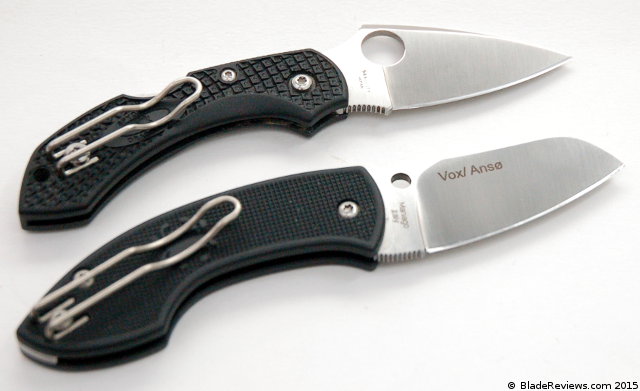

Looks like a handy little job. I think it would make a great first knife for a youngster. I must say spyderco has some interesting stuff set to be tested. The mamba (brend collaboration) definitely made me look twice as well as a few other of the new protos, and I’m a spyderco hater except for my sub hilt (Vallotin) & kriss. As usual you have done a great job and I definitely enjoy, appreciate & look forward to your views. James
James,
Thanks for the very kind comment. I agree, this would make a nice first knife for a kid as it’s very simple.
I agree Spyderco has released some cool stuff at the Amsterdam meet and I have been glued to Spydercollector’s site for the past few weeks checking out all the new stuff. I believe we will be recording a podcast on the subject in the not so distant future.
Dan
Spyderco is one of those fun companies that cater to those that want good production-grade tools despite silly local laws. I know that my Danish friends love them for this. The Pingo, while not my cup of tea, follows in this tradition. Good review, as always.
Both designer’s being from Denmark I always wondered if they named this knife after our King-to-be who was a member of our frogman teams (Equivalent to the US ‘Navy SEALS’) He was nicknamed ‘Pingo’ by the team he was in.